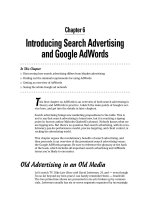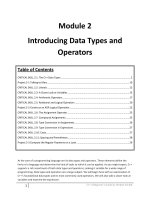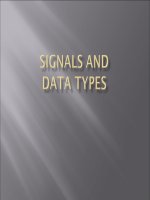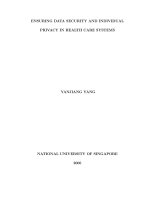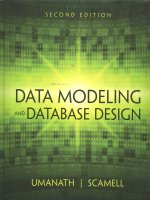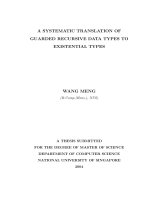Introducing Data Types and Operators
Bạn đang xem bản rút gọn của tài liệu. Xem và tải ngay bản đầy đủ của tài liệu tại đây (721.16 KB, 32 trang )
1
C++ A Beginner’s Guide by Herbert Schildt
Module 2
Introducing Data Types and
Operators
Table of Contents
CRITICAL SKILL 2.1: The C++ Data Types ....................................................................................................... 2
Project 2-1 Talking to Mars ......................................................................................................................... 10
CRITICAL SKILL 2.2: Literals ......................................................................................................................... 12
CRITICAL SKILL 2.3: A Closer Look at Variables ........................................................................................... 15
CRITICAL SKILL 2.4: Arithmetic Operators ................................................................................................... 17
CRITICAL SKILL 2.5: Relational and Logical Operators ................................................................................ 20
Project 2-2 Construct an XOR Logical Operation ........................................................................................ 22
CRITICAL SKILL 2.6: The Assignment Operator ........................................................................................... 25
CRITICAL SKILL 2.7: Compound Assignments .............................................................................................. 25
CRITICAL SKILL 2.8: Type Conversion in Assignments ................................................................................. 26
CRITICAL SKILL 2.9: Type Conversion in Expressions .................................................................................. 27
CRITICAL SKILL 2.10: Casts........................................................................................................................... 27
CRITICAL SKILL 2.11: Spacing and Parentheses ........................................................................................... 28
Project 2-3 Compute the Regular Payments on a Loan .............................................................................. 29
At the core of a programming language are its data types and operators. These elements define the
limits of a language and determine the kind of tasks to which it can be applied. As you might expect, C++
supports a rich assortment of both data types and operators, making it suitable for a wide range of
programming. Data types and operators are a large subject. We will begin here with an examination of
C++’s foundational data types and its most commonly used operators. We will also take a closer look at
variables and examine the expression.
2
C++ A Beginner’s Guide by Herbert Schildt
Why Data Types Are Important
The data type of a variable is important because it determines the operations that are allowed and the
range of values that can be stored. C++ defines several types of data, and each type has unique
characteristics. Because data types differ, all variables must be declared prior to their use, and a variable
declaration always includes a type specifier. The compiler requires this information in order to generate
correct code. In C++ there is no concept of a “type-less” variable.
A second reason that data types are important to C++ programming is that several of the basic types are
closely tied to the building blocks upon which the computer operates: bytes and words. Thus, C++ lets
you operate on the same types of data as does the CPU itself. This is one of the ways that C++ enables
you to write very efficient, system-level code.
CRITICAL SKILL 2.1: The C++ Data Types
C++ provides built-in data types that correspond to integers, characters, floating-point values, and
Boolean values. These are the ways that data is commonly stored and manipulated by a program. As you
will see later in this book, C++ allows you to construct more sophisticated types, such as classes,
structures, and enumerations, but these too are ultimately composed of the built-in types.
At the core of the C++ type system are the seven basic data types shown here:
C++ allows certain of the basic types to have modifiers preceding them. A modifier alters the meaning of
the base type so that it more precisely fits the needs of various situations. The data type modifiers are
listed here:
signed
unsigned
long
short
The modifiers signed, unsigned, long, and short can be applied to int. The modifiers signed and unsigned
can be applied to the char type. The type double can be modified by long. Table 2-1 shows all valid
3
C++ A Beginner’s Guide by Herbert Schildt
combinations of the basic types and the type modifiers. The table also shows the guaranteed minimum
range for each type as specified by the ANSI/ISO C++ standard.
It is important to understand that minimum ranges shown in Table 2-1 are just that: minimum ranges. A
C++ compiler is free to exceed one or more of these minimums, and most compilers do. Thus, the ranges
of the C++ data types are implementation dependent. For example, on computers that use two’s
complement arithmetic (which is nearly all), an integer will have a range of at least −32,768 to 32,767. In
all cases, however, the range of a short int will be a subrange of an int, which will be a subrange of a
long int. The same applies to float, double, and long double. In this usage, the term subrange means a
range narrower than or equal to. Thus, an int and long int can have the same range, but an int cannot be
larger than a long int.
Since C++ specifies only the minimum range a data type must support, you should check your compiler’s
documentation for the actual ranges supported. For example, Table 2-2 shows typical bit widths and
ranges for the C++ data types in a 32-bit environment, such as that used by Windows XP.
Let’s now take a closer look at each data type.
4
C++ A Beginner’s Guide by Herbert Schildt
Integers
As you learned in Module 1, variables of type int hold integer quantities that do not require fractional
components. Variables of this type are often used for controlling loops and conditional statements, and
for counting. Because they don’t have fractional components, operations on int quantities are much
faster than they are on floating-point types.
Because integers are so important to programming, C++ defines several varieties. As shown in Table 2-1,
there are short, regular, and long integers. Furthermore, there are signed and unsigned versions of each.
A signed integer can hold both positive and negative values. By default, integers are signed. Thus, the
use of signed on integers is redundant (but allowed) because the default declaration assumes a signed
value. An unsigned integer can hold only positive values. To create an unsigned integer, use the
unsigned modifier.
The difference between signed and unsigned integers is in the way the high-order bit of the integer is
interpreted. If a signed integer is specified, then the C++ compiler will generate code that assumes that
the high-order bit of an integer is to be used as a sign flag. If the sign flag is 0, then the number is
positive; if it is 1, then the number is negative. Negative numbers are almost always represented using
5
C++ A Beginner’s Guide by Herbert Schildt
the two’s complement approach. In this method, all bits in the number (except the sign flag) are
reversed, and then 1 is added to this number. Finally, the sign flag is set to 1.
Signed integers are important for a great many algorithms, but they have only half the absolute
magnitude of their unsigned relatives. For example, assuming a 16-bit integer, here is 32,767:
0 1 1 1 1 1 1 1 1 1 1 1 1 1 1 1
For a signed value, if the high-order bit were set to 1, the number would then be interpreted as –1
(assuming the two’s complement format). However, if you declared this to be an unsigned int, then
when the high-order bit was set to 1, the number would become 65,535.
To understand the difference between the way that signed and unsigned integers are interpreted by
C++, try this short program:
#include <iostream>
/* This program shows the difference between
signed and unsigned integers. */
using namespace std;
int main()
{
short int i; // a signed short integer short unsigned
int j; // an unsigned short integer
The output from this program is shown here:
-5536 60000
These values are displayed because the bit pattern that represents 60,000 as a short unsigned integer is
interpreted as –5,536 as short signed integer (assuming 16-bit short integers).
C++ allows a shorthand notation for declaring unsigned, short, or long integers. You can simply use the
word unsigned, short,or long, without the int.The int is implied. For example, the following two
statements both declare unsigned integer variables:
unsigned x;
unsigned int y;
6
C++ A Beginner’s Guide by Herbert Schildt
Characters
Variables of type char hold 8-bit ASCII characters such as A, z, or G, or any other 8-bit quantity. To
specify a character, you must enclose it between single quotes. Thus, this assigns X to the variable ch:
char ch;
ch = 'X';
You can output a char value using a cout statement. For example, this line outputs the value in ch:
cout << "This is ch: " << ch;
This results in the following output:
This is ch: X
The char type can be modified with signed or unsigned. Technically, whether char is signed or unsigned
by default is implementation-defined. However, for most compilers char is signed. In these
environments, the use of signed on char is also redundant. For the rest of this book, it will be assumed
that chars are signed entities.
The type char can hold values other than just the ASCII character set. It can also be used as a “small”
integer with the range typically from –128 through 127 and can be substituted for an int when the
situation does not require larger numbers. For example, the following program uses a char variable to
control the loop that prints the alphabet on the screen:
The for loop works because the character A is represented inside the computer by the value 65, and the
values for the letters A to Z are in sequential, ascending order. Thus, letter is initially set to ‘A’. Each time
through the loop, letter is incremented. Thus, after the first iteration, letter is equal to ‘B’.
The type wchar_t holds characters that are part of large character sets. As you may know, many human
languages, such as Chinese, define a large number of characters, more than will fit within the 8 bits
provided by the char type. The wchar_t type was added to C++ to accommodate this situation. While we
7
C++ A Beginner’s Guide by Herbert Schildt
won’t be making use of wchar_t in this book, it is something that you will want to look into if you are
tailoring programs for the international market.
1. What are the seven basic types?
2. What is the difference between signed and unsigned integers?
3. Can a char variable be used like a little integer?
Answer Key:
1. The seven basic types are char, wchar_t, int, float, double, bool, and void.
2. A signed integer can hold both positive and negative values. An unsigned integer can hold only positive values.
3. Yes.
Ask the Expert
Q: Why does C++ specify only minimum ranges for its built-in types rather than stating these precisely?
A: By not specifying precise ranges, C++ allows each compiler to optimize the data types for the
execution environment. This is part of the reason that C++ can create high-performance software. The
ANSI/ISO C++ standard simply states that the built-in types must meet certain requirements. For
example, it states that an int will “have the natural size suggested by the architecture of the execution
environment.” Thus, in a 32-bit environment, an int will be 32 bits long. In a 16-bit environment, an int
will be 16 bits long. It would be an inefficient and unnecessary burden to force a 16-bit compiler to
implement int with a 32-bit range, for example. C++’s approach avoids this. Of course, the C++ standard
does specify a minimum range for the built-in types that will be available in all environments. Thus, if
you write your programs in such a way that these minimal ranges are not exceeded, then your program
will be portable to other environments. One last point: Each C++ compiler specifies the range of the
basic types in the header <climits>.
8
C++ A Beginner’s Guide by Herbert Schildt
Floating-Point Types
Variables of the types float and double are employed either when a fractional component is required or
when your application requires very large or small numbers. The difference between a float and a
double variable is the magnitude of the largest (and smallest) number that each one can hold. Typically,
a double can store a number approximately ten times larger than a float. Of the two, double is the most
commonly used. One reason for this is that many of the math functions in the C++ function library use
double values. For example, the sqrt( ) function returns a double value that is the square root of its
double argument. Here, sqrt( ) is used to compute the length of the hypotenuse given the lengths of the
two opposing sides.
The output from the program is shown here:
Hypotenuse is 6.40312
One other point about the preceding example: Because sqrt( ) is part of the C++ standard function
library, it requires the standard header <cmath>, which is included in the program.
The long double type lets you work with very large or small numbers. It is most useful in scientific
programs. For example, the long double type might be useful when analyzing astronomical data.
The bool Type
The bool type is a relatively recent addition to C++. It stores Boolean (that is, true/false) values. C++
defines two Boolean constants, true and false, which are the only two values that a bool value can have.
Before continuing, it is important to understand how true and false are defined by C++. One of the
fundamental concepts in C++ is that any nonzero value is interpreted as true and zero is false. This
9
C++ A Beginner’s Guide by Herbert Schildt
concept is fully compatible with the bool data type because when used in a Boolean expression, C++
automatically converts any nonzero value into true. It automatically converts zero into false. The reverse
is also true; when used in a non-Boolean expression, true is converted into 1, and false is converted into
zero. The convertibility of zero and nonzero values into their Boolean equivalents is especially important
when using control statements, as you will see in Module 3. Here is a program that demonstrates the
bool type:
// Demonstrate bool values.
#include <iostream>
The output generated by this program is shown here:
b is 0
b is 1
This is executed.
10 > 9 is 1
There are three interesting things to notice about this program. First, as you can see, when a bool value
is output using cout, 0 or 1 is displayed. As you will see later in this book, there is an output option that
causes the words “false” and “true” to be displayed.
Second, the value of a bool variable is sufficient, by itself, to control the if statement. There is no need to
write an if statement like this:
if(b == true) ...
10
C++ A Beginner’s Guide by Herbert Schildt
Third, the outcome of a relational operator, such as <, is a Boolean value. This is why the expression 10 >
9 displays the value 1. Further, the extra set of parentheses around 10 > 9 is necessary because the <<
operator has a higher precedence than the >.
void
The void type specifies a valueless expression. This probably seems strange now, but you will see how
void is used later in this book.
1. What is the primary difference between float and double?
2. What values can a bool variable have? To what Boolean value does zero convert?
3. What is void?
Answer Key:
1. The primary difference between float and double is in the magnitude of the values they can hold.
2. Variables of type bool can be either true or false. Zero converts to false.
3. void is a type that stands for valueless.
Project 2-1 Talking to Mars
At its closest point to Earth, Mars is approximately 34,000,000 miles away. Assuming there is someone
on Mars that you want to talk with, what is the delay between the time a radio signal leaves Earth and
the time it arrives on Mars? This project creates a program that answers this question. Recall that radio
signals travel at the speed of light, approximately 186,000 miles per second. Thus, to compute the delay,
you will need to divide the distance by the speed of light. Display the delay in terms of seconds and also
in minutes.
Step by Step
1. Create a new file called Mars.cpp.
2. To compute the delay, you will need to use floating-point values. Why? Because the time interval
will have a fractional component. Here are the variables used by the program:
double distance;
11
C++ A Beginner’s Guide by Herbert Schildt
double lightspeed;
double delay;
double delay_in_min;
3. Give distance and lightspeed initial values, as shown here:
distance = 34000000.0; // 34,000,000 miles
lightspeed = 186000.0; // 186,000 per second
4. To compute the delay, divide distance by lightspeed. This yields the delay in seconds. Assign this
value to delay and display the results. These steps are shown here:
delay = distance / lightspeed;
cout << "Time delay when talking to Mars: " << delay << " seconds.\n";
5. Divide the number of seconds in delay by 60 to obtain the delay in minutes; display that result using
these lines of code:
delay_in_min = delay / 60.0;
6. Here is the entire Mars.cpp program listing:
/*
Project 2-1
Talking to Mars
*/
#include <iostream>
using namespace std;
int main()
{
double distance;
double lightspeed;
double delay;
double delay_in_min;
distance = 34000000.0; // 34,000,000 miles
lightspeed = 186000.0; // 186,000 per second
delay = distance / lightspeed;
cout << "Time delay when talking to Mars: " << delay << " seconds.\n";
delay_in_min = delay / 60.0;
cout << "This is " << delay_in_min << " minutes.";
12
C++ A Beginner’s Guide by Herbert Schildt
return 0;
}
7. Compile and run the program. The following result is displayed:
Time delay when talking to Mars: 182.796 seconds.
This is 3.04659 minutes.
8. On your own, display the time delay that would occur in a bidirectional conversation with Mars.
CRITICAL SKILL 2.2: Literals
Literals refer to fixed, human-readable values that cannot be altered by the program. For example, the
value 101 is an integer literal. Literals are also commonly referred to as constants. For the most part,
literals and their usage are so intuitive that they have been used in one form or another by all the
preceding sample programs. Now the time has come to explain them formally.
C++ literals can be of any of the basic data types. The way each literal is represented depends upon its
type. As explained earlier, character literals are enclosed between single quotes. For example, ‘a’ and ‘%’
are both character literals.
Integer literals are specified as numbers without fractional components. For example, 10 and –100 are
integer constants. Floating-point literals require the use of the decimal point followed by the number’s
fractional component. For example, 11.123 is a floating-point constant. C++ also allows you to use
scientific notation for floating-point numbers.
All literal values have a data type, but this fact raises a question. As you know, there are several different
types of integers, such as int, short int, and unsigned long int. There are also three different
floating-point types: float, double, and long double. The question is: How does the compiler determine
the type of a literal? For example, is 123.23 a float or a double? The answer to this question has two
parts. First, the C++ compiler automatically makes certain assumptions about the type of a literal and,
second, you can explicitly specify the type of a literal, if you like.
By default, the C++ compiler fits an integer literal into the smallest compatible data type that will hold it,
beginning with int. Therefore, assuming 16-bit integers, 10 is int by default, but 103,000 is long. Even
though the value 10 could be fit into a char, the compiler will not do this because it means crossing type
boundaries.
By default, floating-point literals are assumed to be double. Thus, the value 123.23 is of type double.
For virtually all programs you will write as a beginner, the compiler defaults are perfectly adequate. In
cases where the default assumption that C++ makes about a numeric literal is not what you want, C++
allows you to specify the exact type of numeric literal by using a suffix. For floating-point types, if you
follow the number with an F, the number is treated as a float. If you follow it with an L, the number
becomes a long double. For integer types, the U suffix stands for unsigned and the L for long. (Both the
U and the L must be used to specify an unsigned long.) Some examples are shown here:
